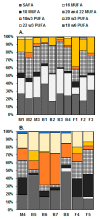Comparison of Diatoms and Dinoflagellates from Different Habitats as Sources of PUFAs
- PMID: 31010188
- PMCID: PMC6521115
- DOI: 10.3390/md17040233
Comparison of Diatoms and Dinoflagellates from Different Habitats as Sources of PUFAs
Abstract
Recent studies have clearly shown the importance of omega-3 (ω-3) and omega-6 (ω-6) polyunsaturated fatty acids (PUFAs) for human and animal health. The long-chain eicosapentaenoic acid (EPA; 20:5ω-3) and docosahexaenoic acid (DHA; 22:6ω-3) are especially recognized for their nutritional value, and ability to alleviate many diseases in humans. So far, fish oil has been the main human source of EPA and DHA, but alternative sources are needed to satisfy the growing need for them. Therefore, we compared a fatty acid profile and content of 10 diatoms and seven dinoflagellates originating from marine, brackish and freshwater habitats. These two phytoplankton groups were chosen since they are excellent producers of EPA and DHA in aquatic food webs. Multivariate analysis revealed that, whereas the phytoplankton group (46%) explained most of the differences in the fatty acid profiles, habitat (31%) together with phytoplankton group (24%) explained differences in the fatty acid contents. In both diatoms and dinoflagellates, the total fatty acid concentrations and the ω-3 and ω-6 PUFAs were markedly higher in freshwater than in brackish or marine strains. Our results show that, even though the fatty acid profiles are genetically ordered, the fatty acid contents may vary greatly by habitat and affect the ω-3 and ω-6 availability in food webs.
Keywords: DHA; EPA; brackish; diatoms; dinoflagellates; freshwater; marine; microalgae; polyunsaturated fatty acids.
Conflict of interest statement
The authors declare no conflict of interest. The funders had no role in the design of the study; in the collection, analyses, or interpretation of data; in the writing of the manuscript, or in the decision to publish the results.
Figures



Similar articles
-
Variation in ω-3 and ω-6 Polyunsaturated Fatty Acids Produced by Different Phytoplankton Taxa at Early and Late Growth Phase.Biomolecules. 2020 Apr 6;10(4):559. doi: 10.3390/biom10040559. Biomolecules. 2020. PMID: 32268552 Free PMC article.
-
Climate warming is predicted to reduce omega-3, long-chain, polyunsaturated fatty acid production in phytoplankton.Glob Chang Biol. 2016 Aug;22(8):2744-55. doi: 10.1111/gcb.13295. Epub 2016 Jun 6. Glob Chang Biol. 2016. PMID: 27070119
-
Omega-3 Polyunsaturated Fatty Acids and Their Health Benefits.Annu Rev Food Sci Technol. 2018 Mar 25;9:345-381. doi: 10.1146/annurev-food-111317-095850. Annu Rev Food Sci Technol. 2018. PMID: 29350557 Review.
-
Towards the Industrial Production of Omega-3 Long Chain Polyunsaturated Fatty Acids from a Genetically Modified Diatom Phaeodactylum tricornutum.PLoS One. 2015 Dec 14;10(12):e0144054. doi: 10.1371/journal.pone.0144054. eCollection 2015. PLoS One. 2015. PMID: 26658738 Free PMC article.
-
Fortification of foods with omega-3 polyunsaturated fatty acids.Crit Rev Food Sci Nutr. 2014;54(1):98-114. doi: 10.1080/10408398.2011.578221. Crit Rev Food Sci Nutr. 2014. PMID: 24188235 Review.
Cited by
-
Diatoms for Carbon Sequestration and Bio-Based Manufacturing.Biology (Basel). 2020 Aug 10;9(8):217. doi: 10.3390/biology9080217. Biology (Basel). 2020. PMID: 32785088 Free PMC article. Review.
-
Effects of combined temperature and salinity on growth and fatty acid content of two Korean isolates of Akashiwo sanguinea (Dinophyceae).Sci Rep. 2025 Jul 24;15(1):26904. doi: 10.1038/s41598-025-11928-5. Sci Rep. 2025. PMID: 40707529 Free PMC article.
-
Microalgae as Sustainable Bio-Factories of Healthy Lipids: Evaluating Fatty Acid Content and Antioxidant Activity.Mar Drugs. 2021 Jun 23;19(7):357. doi: 10.3390/md19070357. Mar Drugs. 2021. PMID: 34201621 Free PMC article.
-
Antarctic Krill Oil Attenuates Oxidative Stress via the KEAP1-NRF2 Signaling in Patients with Coronary Heart Disease.Evid Based Complement Alternat Med. 2020 Oct 7;2020:9534137. doi: 10.1155/2020/9534137. eCollection 2020. Evid Based Complement Alternat Med. 2020. PMID: 33082834 Free PMC article.
-
Effects of Replacing Corn with an Aged Brown Rice-Wheat Mixture on Laying Performance, Egg Quality and Nutrient Digestibility in Laying Ducks.Animals (Basel). 2025 Apr 9;15(8):1088. doi: 10.3390/ani15081088. Animals (Basel). 2025. PMID: 40281921 Free PMC article.
References
-
- Twining C.W., Brenna J.T., Hairston N.G., Flecker A.S. Highly unsaturated fatty acids in nature: What we know and what we need to learn. Oikos. 2016;125:749–760. doi: 10.1111/oik.02910. - DOI
MeSH terms
Substances
Grants and funding
LinkOut - more resources
Full Text Sources
Research Materials

